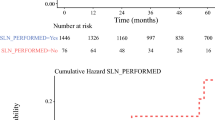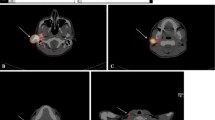Abstract
Background
A positive sentinel lymph node (SLN) is the most important prognostic factor for predicting survival in cutaneous melanoma. This study aimed to evaluate how the addition of single-photon emission computed tomography (SPECT) and computed tomography (CT) to planar lymphoscintigraphy (PL) alters SLN identification, yield, and localization of metastatic nodes in head and neck melanoma.
Methods
This retrospective review examined patients undergoing SLN biopsy for cutaneous melanoma of the head and neck between July 2003 and December 2015. Patient demographics and pathologic outcomes were compared for patients undergoing SPECT-CT versus PL. A multivariable logistic regression analysis was used to identify factors associated with the identification of a positive SLN.
Results
Among 176 patients undergoing SLN biopsy, 91 underwent PL and 85 underwent SPECT-CT and PL. The patients in the SPECT-CT group were older than the PL patients (p = 0.050) but the groups did not differ in gender (p = 0.447), Breslow thickness (p = 0.744), or total number of SLNs identified (p = 0.633). As shown by the multivariate regression analysis, only Breslow thickness [odds ratio (OR) 1.47; 95 % confidence interval (CI) 1.17–1.84] and SPECT-CT (OR 3.58; 95 % CI 1.24–10.4) were associated with a positive SLN.
Conclusion
The use of SPECT-CT for patients with head and neck cutaneous melanoma significantly increases the likelihood of retrieving a positive SLN. Long-term follow-up evaluation is needed for further definition of the impact that SPECT-CT has on recurrence and survival.

Similar content being viewed by others
References
Testori A, De Salvo GL, Montesco MC, et al. Clinical considerations on sentinel node biopsy in melanoma from an Italian multicentric study on 1313 patients (SOLISM-IMI). Ann Surg Oncol. 2009;16:2018–27.
Morton DL, Thompson JF, Cochran AJ, et al. Sentinel-node biopsy or nodal observation in melanoma. N Engl J Med. 2006;355:1307–17.
Morton DL, Thompson JF, Cochran AJ, et al. Final trial report of sentinel-node biopsy versus nodal observation in melanoma. N Engl J Med. 2014;370:599–609.
Erman AB, Collar RM, Griffith KA, et al. Sentinel lymph node biopsy is accurate and prognostic in head and neck melanoma. Cancer. 2012;118:1040–7.
Morton DL, Cochran AJ, Thompson JF, et al. Sentinel node biopsy for early-stage melanoma: accuracy and morbidity in MSLT-I, an international multicenter trial. Ann Surg. 2005;242:302–11; discussion 11–3.
Fairbairn N, Munson C, Khan ZA, Butterworth M. The role of hybrid SPECT/CT for lymphatic mapping in patients with melanoma. J Plast Reconstr Aesthet Surg. 2013;66:1248–55.
Veenstra HJ, Vermeeren L, Olmos RA, Nieweg OE. The additional value of lymphatic mapping with routine SPECT/CT in unselected patients with clinically localized melanoma. Ann Surg Oncol. 2012;19:1018–23.
van der Ploeg IM, Valdes Olmos RA, Kroon BB, et al. The yield of SPECT/CT for anatomical lymphatic mapping in patients with melanoma. Ann Surg Oncol. 2009;16:1537–42.
Bennie G, Vorster M, Buscombe J, Sathekge M. The added value of a single-photon emission computed tomography-computed tomography in sentinel lymph node mapping in patients with breast cancer and malignant melanoma. World J Nucl Med. 2015;14:41–6.
Jimenez-Heffernan A, Ellmann A, Sado H, et al. Results of a prospective multicenter international atomic energy agency sentinel node trial on the value of SPECT/CT over planar imaging in various malignancies. J Nucl Med. 2015;56:1338–44.
Stoffels I, Boy C, Poppel T, et al. Association between sentinel lymph node excision with or without preoperative SPECT/CT and metastatic node detection and disease-free survival in melanoma. JAMA. 2012;308:1007–14.
Vermeeren L, Valdes Olmos RA, et al. SPECT/CT for sentinel lymph node mapping in head and neck melanoma. Head Neck. 2011;33:1–6.
Klode J, Poeppel T, Boy C, et al. Advantages of preoperative hybrid SPECT/CT in detection of sentinel lymph nodes in cutaneous head and neck malignancies. J Eur Acad Dermatol Venereol. 2011;25:1213–21.
Zender C, Guo T, Weng C, Faulhaber P, Rezaee R. Utility of SPECT/CT for periparotid sentinel lymph node mapping in the surgical management of head and neck melanoma. Am J Otolaryngol. 2014;35:12–8.
Chao C, Wong SL, Ross MI, et al. Patterns of early recurrence after sentinel lymph node biopsy for melanoma. Am J Surg. 2002;184:520–4; discussion 5.
Scoggins CR, Martin RC, Ross MI, et al. Factors associated with false-negative sentinel lymph node biopsy in melanoma patients. Ann Surg Oncol. 2010;17:709–17.
Miller MW, Vetto JT, Monroe MM, Weerasinghe R, Andersen PE, Gross ND. False-negative sentinel lymph node biopsy in head and neck melanoma. Otolaryngol Head Neck Surg. 2011;145:606–11.
Balch CM, Thompson JF, Gershenwald JE, et al. Age as a predictor of sentinel node metastasis among patients with localized melanoma: an inverse correlation of melanoma mortality and incidence of sentinel node metastasis among young and old patients. Ann Surg Oncol. 2014;21:1075–81.
Conflict of interest
The authors declare that they have no conflicts of interest.
Author information
Authors and Affiliations
Corresponding author
Rights and permissions
About this article
Cite this article
Chapman, B.C., Gleisner, A., Kwak, J.J. et al. SPECT/CT Improves Detection of Metastatic Sentinel Lymph Nodes in Patients with Head and Neck Melanoma. Ann Surg Oncol 23, 2652–2657 (2016). https://doi.org/10.1245/s10434-016-5175-6
Received:
Published:
Issue Date:
DOI: https://doi.org/10.1245/s10434-016-5175-6




